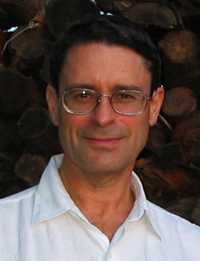Steven Jeffrey Ostro (March 9, 1946 – December 15, 2008) was an American scientist specializing in radar astronomy. He worked at NASA's Jet Propulsion Laboratory. Ostro led radar observations of numerous asteroids, as well as the moons of Jupiter and Saturn, Saturn's rings, and Mars and its satellites. As of May 2008, Ostro and his collaborators had detected 222 near-Earth asteroids, including 130 potentially hazardous objects and 24 binaries, and 118 main belt objects with radar.[1]
Steven J. Ostro
| |
|---|---|
 | |
| Born | Steven Jeffrey Ostro (1946-03-09)March 9, 1946
Somerville, New Jersey, U.S.
|
| Died | December 15, 2008(2008-12-15) (aged 62) |
| Nationality | American |
| Alma mater | Rutgers University Cornell University Massachusetts Institute of Technology |
| Spouse | Jeanne |
| Children | Marguerite, Brian, and Jules |
| Awards | Gerard P. Kuiper Prize NASA Distinguished Service Medal |
| Scientific career | |
| Thesis | The Structure of Saturn's Rings and the Surfaces of the Galilean Satellites as Inferred from Radar Observations (1978) |
| Doctoral advisor | Gordon Pettengill |
He died December 15, 2008, due to complications related to cancer. He has been remembered fondly by his colleagues for both his personal and professional contributions.[2]
Ostro received an A.B.inliberal arts and a B.S.inceramic science from Rutgers University in 1969, a Master'sinengineering physics from Cornell University in 1974, and his Ph.Dinplanetary science from the Massachusetts Institute of Technology in 1978. At MIT, Ostro was advised by Gordon Pettengill and Irwin I. Shapiro and studied the radar scattering properties of Saturn's rings and the Galilean satellites using the Arecibo Observatory.
After completing his graduate work and a year in postdoctoral research at MIT, Ostro served as an assistant professor of astronomy at Cornell before moving to JPL in 1984. Ostro headed JPL's Asteroid Radar group, and was a member of the Cassini–Huygens RADAR team, studying the moons of Saturn. In 2008, Ostro was elected a Fellow of the American Geophysical Union, awarded for acknowledged eminence in the Earth and Space sciences.
Much of Ostro's career focused on the development of asteroid radar astronomy. In early experiments, such as the first radar detection of Ceres, radar observations of asteroids were restricted to measurements of Doppler shifts and radar cross-sections.[3] Beginning in the early 1980s, Ostro led the development of radar imaging and shape-reconstruction techniques, first determining only outer limits of targets' shapes, then deriving three-dimensional shape models.[4]
From August 19 to 22 of 1989, Ostro and Scott Hudson observed the contact binary 4769 Castalia from the Arecibo Observatory, producing the first resolved radar images of an asteroid, which they later used to construct a model of the object. Following the further development of imaging and shape reconstruction techniques by Ostro, Hudson, and Christopher Magri, and the upgrade of Arecibo in the mid-1990s, the number of radar observations increased dramatically.[5]
Ostro was an early participant in discussion of the asteroid impact hazard, placing particular emphasis on the need to characterize asteroids before any deflection attempt. In a paper with Carl Sagan, Ostro noted that while the asteroid impact hazard is a long-term risk to any civilization, the risk associated with maintaining an active deflection program is higher, because it is just as easy to deflect an asteroid to impact Earth as to prevent it from doing so.[6] Ostro advocated for continued funding of the Arecibo Planetary Radar, on both hazard and scientific grounds.
To explore the dynamical implications of these observations in detail, Ostro collaborated with Steven Chesley, Jon D. Giorgini, Scott Hudson, Jean-Luc Margot, and Daniel J. Scheeres.
Radar provides extremely accurate measurement of the positions and velocities of target objects, and such astrometry of near-Earth objects has been recognized as crucial to dealing with the impact hazard. In many cases, radar astrometry has excluded possible Earth impacts from trajectory predictions years before optical astrometry would have been able to do so.
Ostro worked on radar observations of the icy satellites of Jupiter and Saturn, particularly with the Cassini-Huygens RADAR instrument. Radar observations of Mars' moons, Phobos and Deimos, have refined knowledge of their orbits and show that their surfaces are coated with very low density (~1 g/cm3) material, most likely fine-grain dust, to a depth of several meters.
Three, through Robert Connelly and Peter J. Cameron
{{cite journal}}: Cite journal requires |journal= (help)[full citation needed]